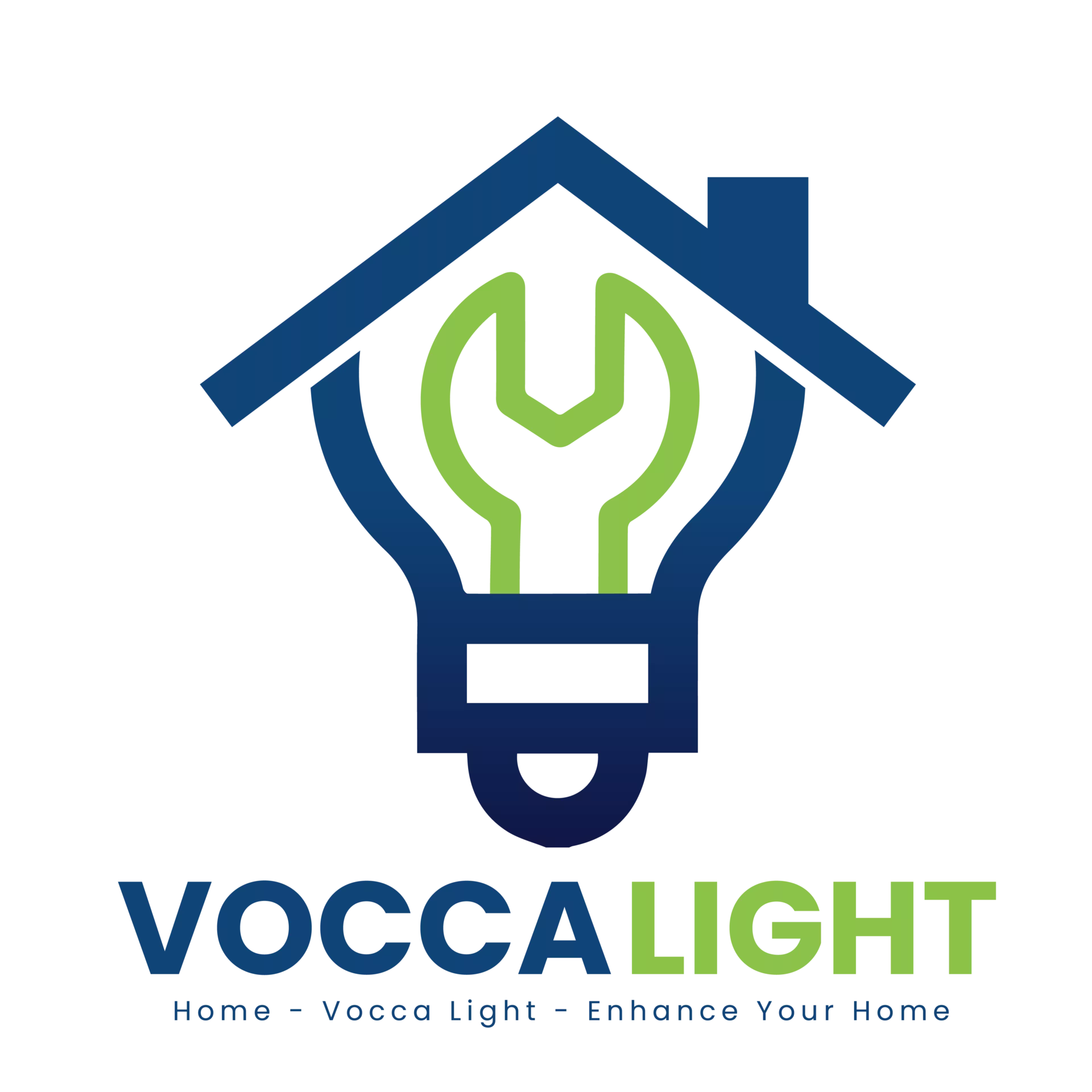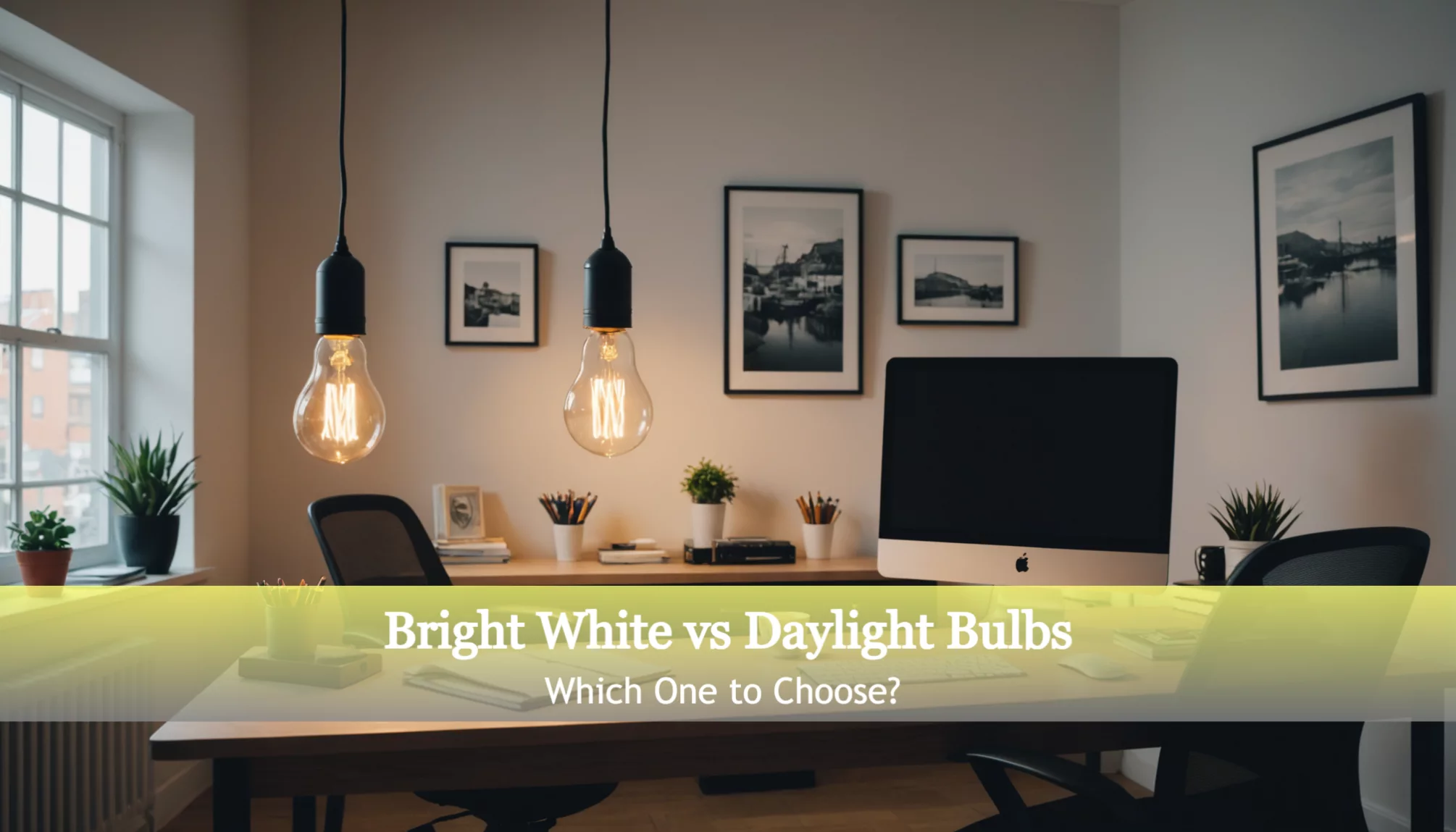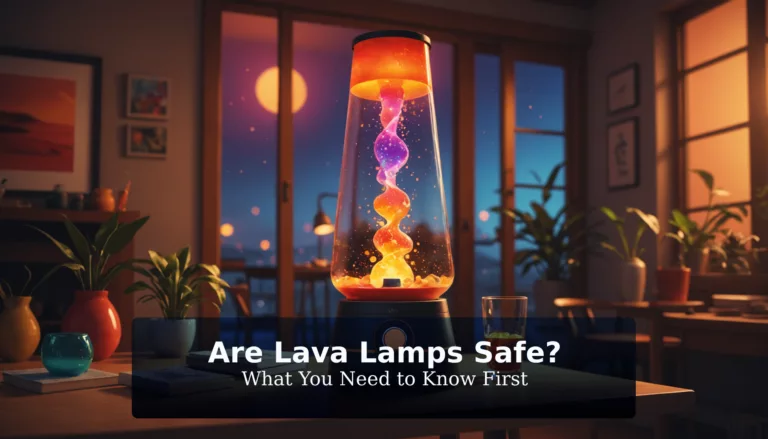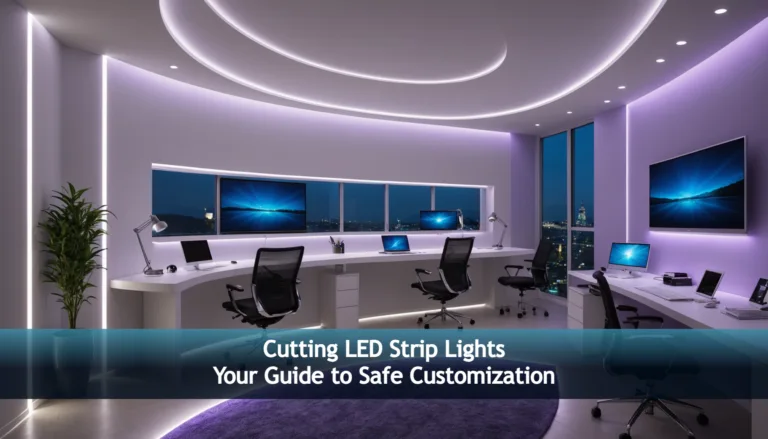Bright White vs Daylight Bulbs: Which One to Choose?
When it comes to lighting your home, the choice between bright white vs daylight bulbs can make a big difference in how your space feels! Bright white bulbs give off a clean, crisp light, while daylight bulbs mimic natural sunlight, making your rooms feel more vibrant. Understanding these differences is essential because the right lighting can enhance your mood, improve visibility, and even help you focus better on tasks.
If you overlook the impact of color temperature and brightness, your living spaces may end up feeling dull or harsh. In this article, we’ll explore what bright white and daylight bulbs are, their key differences, and how to choose the perfect lighting for your workspace or cozy corners. Get ready to brighten up your home with the best illumination possible, and let’s dive into the world of lighting!
Understanding Bright White and Daylight Bulbs
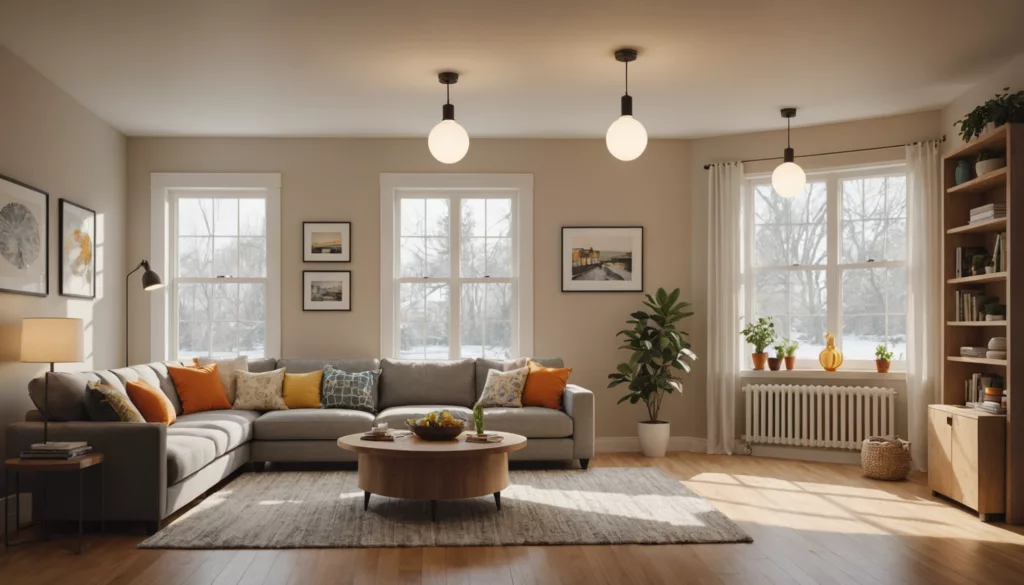
Light bulbs come in different color temperatures that affect how spaces look and feel. Understanding the key differences helps in selecting the right lighting for each room.
What Are Bright White Bulbs?
Bright white bulbs create light with color temperatures between 3000K and 4000K. These bulbs produce a clean, white light that works well in kitchens, bathrooms, and work areas. The balanced output helps reduce eye strain while keeping spaces feeling warm and welcoming. Bright white lighting creates an ideal mix of comfort and clarity for everyday activities.
What Are Daylight Bulbs?
Daylight bulbs shine at higher color temperatures of 5000K to 6500K. These bulbs match natural sunlight by creating a crisp, bluish-white glow. Artists and office workers often choose daylight bulbs because they show colors accurately. The bright, clear light helps with detailed tasks like reading, writing, and crafting.
Key Differences Between Bright White and Daylight Light Bulbs
Color Temperature:
- Bright white: 3000K-4000K, creates balanced white light
- Daylight: 5000K-6500K, produces bluish-white light like natural sun
Best Uses:
- Bright white bulbs work well in:
- Kitchens and bathrooms
- Living rooms and bedrooms
- Home offices and workspaces
- Daylight bulbs excel in:
- Art studios and craft rooms
- Professional offices
- Reading nooks and study areas
Light Effects:
- Bright white offers a gentle, welcoming glow
- Daylight provides sharp, invigorating illumination
- Both reduce eye strain when used in proper settings
Exploring Color Temperature in Light Bulbs

Color temperature determines how warm or cool light appears in a space. Measured in Kelvins (K), this important factor helps create the right atmosphere for any room. Understanding color temperature makes choosing the right bulbs simple and effective.
What is Color Temperature?
Color temperature measures light appearance on a Kelvin (K) scale. Lower temperatures (2700K-3000K) create warm, yellowish light perfect for relaxation. Higher temperatures (5000K-6500K) produce cool, bluish light that mimics natural daylight. Think of it like this: warm colors feel cozy, while cool colors energize.
Bright White vs Daylight Temperature
Bright white bulbs (3000K-4000K) strike a balance between warm and cool light. These bulbs create comfortable illumination that works well in living rooms and bedrooms. The neutral glow enhances visibility while maintaining a welcoming atmosphere.
Daylight bulbs (5000K-6500K) closely match natural sunlight. Their crisp, clear light improves focus and reduces eye strain. This makes them ideal for:
- Home offices
- Art studios
- Reading nooks
- Detailed task areas
| Light Type | Temperature Range | Best Uses |
|---|---|---|
| Bright White | 3000K-4000K | Living spaces, bedrooms |
| Daylight | 5000K-6500K | Workspaces, detailed tasks |
Choosing the Right Temperature
Select lighting based on room function and desired mood:
For Relaxation (Bright White):
- Living rooms
- Bedrooms
- Family spaces
- Dining areas
For Focus (Daylight):
- Home offices
- Craft rooms
- Garages
- Workshops
Match the light temperature to activities in each space. Bright white creates comfort for social areas, while daylight enhances productivity in work zones.
Learn more about color temperature basics at Energy.gov’s Lighting Guide.
Factors to Consider: Brightness and Lumen Output

Light brightness plays a crucial role in creating the right environment for different activities. Understanding how brightness works helps in selecting the ideal bulb for each space.
Understanding Lumen Ratings in Bright White and Daylight Bulbs
Lumens tell how much light a bulb produces. A higher lumen rating means a brighter light. Both bright white and daylight bulbs typically offer 800-1200 lumens of light output. The key difference lies in how the light appears to the eye.
Bright white bulbs (3000K-4000K) create:
- Warm, welcoming illumination
- Clear visibility without harshness
- Comfortable light for everyday tasks
Daylight bulbs (5000K-6500K) deliver:
- Sharp, crisp lighting
- Enhanced color accuracy
- Maximum task visibility
Are Bright White or Daylight Bulbs Brighter?
The actual brightness depends on the lumen output, not the color temperature. A 1000-lumen bright white bulb produces the same amount of light as a 1000-lumen daylight bulb. However, daylight bulbs often appear brighter because:
- The blue-white light mimics natural sunlight
- Cool light creates better contrast
- Human eyes perceive cool light as more intense
The best choice depends on the room’s purpose. Match the brightness level to the activities that happen in the space for optimal lighting results.
Department of Energy
Lighting Design Lab
Smart Light Integration: Bright White or Daylight?
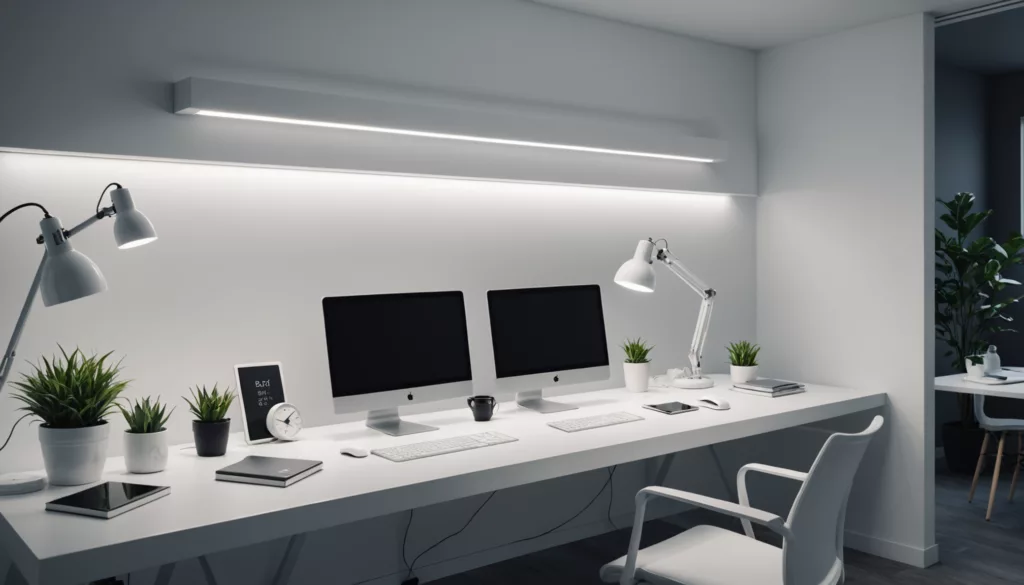
Smart lighting technology transforms how homes and offices use bright white and daylight bulbs. This section explores the key features and benefits of smart lighting integration.
Benefits of Smart Light Technology
Smart lighting systems offer precise control over brightness and color temperature. These systems connect to mobile devices or smart home hubs for remote operation.
Key advantages include:
- Remote control of lights from any location
- Automatic scheduling for energy savings
- Color temperature adjustments between 3000K-6500K
- Integration with other smart home devices
- Energy usage tracking and optimization
Which Lighting Works Best for Smart Bulbs?
Both bright white (3000K-4000K) and daylight (5000K-6500K) options excel in smart lighting applications. The choice depends on the room’s purpose:
Bright White Smart Bulbs (3000K-4000K):
- Perfect for living rooms and bedrooms
- Creates a warm, inviting atmosphere
- Ideal for evening relaxation
- Reduces eye strain during casual activities
Daylight Smart Bulbs (5000K-6500K):
- Best for home offices and craft rooms
- Enhances focus and productivity
- Provides accurate color rendering
- Mimics natural sunlight for better visibility
Customizing Bright White and Daylight Colors
Smart bulbs allow seamless transitions between bright white and daylight settings throughout the day. Modern smart lighting systems offer:
Color Temperature Control:
- Morning: Gentle bright white (3000K)
- Midday: Crisp daylight (5000K-6500K)
- Evening: Warm bright white (3500K)
Automated Features:
- Time-based color shifting
- Activity-specific presets
- Motion-activated adjustments
- Voice control compatibility
Smart bulbs typically produce 800-1200 lumens, providing ample brightness for most spaces. The ability to adjust both color temperature and brightness creates the perfect lighting environment for any activity or time of day.
Expert Recommendations on Bright White and Daylight Lighting

Understanding the practical applications of different lighting types helps create optimal environments for various activities. Here’s a comprehensive guide for selecting between bright white and daylight bulbs.
Best Applications for Bright White Bulbs
Bright white bulbs create inviting atmospheres in residential spaces with their 3000-4000 Kelvin light output. These applications maximize their warming effects:
- Living rooms and family areas
- Bedrooms and reading nooks
- Dining rooms and entertainment spaces
- Hallways and entryways
- Bathrooms for grooming tasks
The warm glow enhances relaxation while providing sufficient illumination for daily activities.
Ideal Scenarios for Using Daylight Bulbs
Daylight bulbs (5000-6500 Kelvin) excel in task-oriented environments requiring clear visibility:
- Home offices and study areas
- Kitchen workspaces
- Craft rooms and workshops
- Reading areas requiring focus
- Basements needing brighter light
The crisp, bluish-white illumination improves concentration and reduces eye strain during detail work.
Tips for Choosing Between Bright White and Daylight
Consider these key factors when selecting bulbs:
Room Purpose:
- Select bright white for relaxation spaces
- Install daylight bulbs in task-focused areas
- Match lighting to primary room activities
Time of Use:
- Bright white works well for evening spaces
- Daylight bulbs suit daytime activity areas
- Consider smart bulbs for automated adjustment
Light Requirements:
- Measure existing natural light
- Account for surface colors and textures
- Factor in ceiling height and room size
Conclusion
In this article, we explored the differences between bright white and daylight bulbs. Bright white bulbs provide a clean, crisp light that can enhance visibility in spaces like kitchens and work areas. On the other hand, daylight bulbs mimic natural sunlight, making them perfect for living spaces where you want to feel cozy yet energized.
We also discussed how color temperature affects the mood and productivity in your workspace. Remember, choosing the right bulb can make a big difference in how your rooms feel! So, whether you need bright white light for detailed tasks or the warm glow of daylight for relaxation, you now have the knowledge to make an informed choice. Keep experimenting with different lighting options to find what works best for you!
FAQs
1. What are the benefits of bright white bulbs in homes?
Bright white bulbs (3000K-4000K) create an energizing atmosphere, provide clear illumination, enhance visibility, complement modern décor, reduce eye strain, and work well in multi-purpose spaces.
2. What problems can mixing light bulb types in fixtures cause?
Mixing bulb types can cause uneven light distribution, inconsistent color rendering, visual discomfort, and reduced fixture efficiency.
3. How should I select workspace lighting?
Consider task requirements (color accuracy, brightness), room characteristics (natural light, colors, ceiling height), and environmental factors (hours of operation, energy efficiency).
